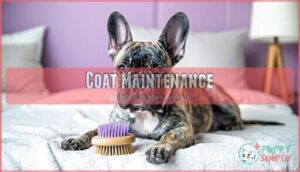This site is supported by our readers. We may earn a commission, at no cost to you, if you purchase through links.

This stunning color comes from diluted genes that create their signature lavender hue, but it’s not just about looks.
These pups carry the same lovable, couch-potato personality as regular Frenchies, though their unique genetics can make them prone to skin sensitivity and color dilution alopecia.
Expect to pay premium prices for this eye-catching companion, often double what you’d spend on standard colors, due to their rare nature.
Their care requirements tell a different story though.
Table Of Contents
- Key Takeaways
- Lilac French Bulldog Overview
- Lilac French Bulldog Genetics
- Lilac French Bulldog Appearance
- Lilac French Bulldog Health Issues
- Lilac French Bulldog Care Tips
- Lilac French Bulldog Grooming Needs
- Lilac French Bulldog Price Range
- Lilac French Bulldog Recognition
- Lilac French Bulldog Ownership
- Frequently Asked Questions (FAQs)
- Are lilac French Bulldogs rare?
- How do I know if my Frenchie is lilac?
- What is the average life expectancy of a Lilac French Bulldog?
- How often should Lilac French Bulldogs be groomed?
- Are Lilac French Bulldogs suitable for apartment living?
- How much exercise does a Lilac French Bulldog need?
- Are lilac French bulldogs good with children?
- How much exercise do lilac Frenchies need?
- What foods should lilac French bulldogs avoid?
- Do lilac French bulldogs shed more than others?
- Conclusion
Key Takeaways
- You’ll pay premium prices ($5,000-$15,000) for these rare beauties since they need specific chocolate and blue genes from both parents to create their stunning lavender-gray coat.
- You’ll need to provide specialized care including gentle hypoallergenic products, sun protection, and protective footwear since their diluted genetics make them prone to skin sensitivity and Color Dilution Alopecia.
- You can’t show them in AKC conformation events since lilac isn’t an officially recognized color, but they’ll still make loving family companions with the same playful French Bulldog personality.
- You’ll face higher health risks including breathing problems from their flat faces, potential deafness from color genes, and skin conditions that require ongoing veterinary attention throughout their 10-13 year lifespan.
Lilac French Bulldog Overview
You’ve likely heard about French Bulldogs, but the lilac variety represents one of the rarest and most sought-after color variations in this beloved breed.
These unique pups showcase a stunning pale lavender-gray coat that results from complex genetics, combining both chocolate and blue genes to create their distinctive Isabella coloring.
Rare Color Variant
Few french bulldog colors capture hearts like the lilac variation.
This rare color variation represents the holy grail of french bulldog genetics, making every lilac french bulldog a walking masterpiece.
The breeding demand skyrockets because genetic uniqueness requires specific gene combinations that most breeders can’t achieve.
Desirability factors and investment potential make these rare french bulldog gems incredibly sought-after worldwide, due to their genetic uniqueness.
Unique Personality Traits
Despite their rare coloring, your lilac French bulldog shares the same playful demeanor and affectionate nature as standard Frenchies.
These loyal companions display intelligent behavior that’ll surprise you daily.
Their french bulldog temperament shines through playful antics and loyal personalities that bond deeply with families.
However, proper socialization needs remain essential for developing their naturally affectionate and well-rounded character.
Breed History
You’d be surprised to learn that lilac french bulldogs are relatively new kids on the block.
The first lilac French Bulldog wasn’t born until 2008, making this color variant barely a teenager in dog years.
Early Frenchies from France never displayed these exotic hues.
This genetic timeline shows how modern breeding complexity has evolved since the late 20th century, creating today’s popularity surge in modern breeding.
Lilac French Bulldog Genetics
You’ll need to understand that lilac French Bulldogs get their unique color from a complex combination of recessive genes, specifically requiring both chocolate and blue genes from each parent.
This genetic puzzle makes breeding these rare pups incredibly challenging, since both parents must carry the exact same recessive gene combination to produce that coveted lavender-gray coat.
Color Genetics Explained
Understanding your lilac French bulldog’s genetics involves complex recessive genes working together.
The lilac coat requires specific gene combinations from both parents to create this rare color through dilution processes.
Here’s how lilac genetics work:
- Recessive genes – Both blue (d/d) and cocoa (co/co) genes must be present
- Blue vs. cocoa – Different dilution pathways create varying lilac shades
- Genotype phenotype relationship determines visible coat color expression
- Breeding outcomes require careful genetic planning for lilac puppies
- Color inheritance follows predictable patterns when parents carry correct genes
Gene Mutation Effects
The genetic mutation behind that stunning lilac coat color isn’t just about looks—it comes with real consequences you’ll need to understand.
The price you pay for beauty—lilac genetics create stunning coats but carry hidden health risks every owner must face.
When recessive genes create this rare hue, they can also trigger unexpected health risks that responsible breeders must consider.
| Mutation Effect | Impact on Your Dog |
|---|---|
| Color Dilution Alopecia | Hair thinning and skin irritation |
| Increased Deafness Risk | Inner ear development issues |
| Weakened Immune System | Higher susceptibility to infections |
| Genetic Diseases | Potential for inherited conditions |
| Breeding Ethics Concerns | Limited genetic diversity in bloodlines |
Breeding Challenges
Breeding lilac French Bulldogs isn’t a walk in the park. You’ll face complex genetic puzzles that require both parents to carry specific recessive genes.
Most breeders rely on artificial insemination and C-sections due to birthing complications. The process demands extensive genetic testing and ethical considerations.
Here’s what makes breeding so challenging:
- Genetic Testing Requirements – You need DNA analysis to identify suitable breeding pairs with chocolate and blue gene combinations
- Artificial Insemination Necessity – Natural breeding rarely works due to the breed’s physical limitations and genetic complexity
- Birthing Complications – C-sections are almost always required, adding significant veterinary costs and risks
- Ethical Concerns – Responsible breeders must balance demand for rare colors with potential genetic diseases and health issues
Lilac French Bulldog Appearance
You’ll instantly recognize a lilac French Bulldog by its distinctive pale lavender to deep purple coat that sets it apart from traditional colors.
These compact dogs display the breed’s signature bat ears and muscular build while showcasing unique variations like pure lilac, piebald patterns, or striking merle combinations.
Coat Color Variations
What makes your lilac French bulldog’s coat color so mesmerizing?
Color intensity varies from pale lavender to deep purple hues.
Pattern combinations create stunning visual effects through genetics.
Markings influence overall appearance, with some dogs displaying solid coats while others showcase multicolored patterns.
These rare variations include lilac fawn, lilac platinum, and lilac merle combinations, making each unique coat color truly special.
Pure Lilac Characteristics
Pure lilac French bulldogs showcase their genetics through a stunning pale greyish-brown coat that’s almost ethereal.
You’ll notice minimal markings across their body, creating a clean, uniform appearance.
Their darker muzzle contrasts beautifully with the lighter underbelly, while light-colored eyes complete this rare look.
At ideal weight, these dogs embody coat perfection that’s simply breathtaking.
Piebald Lilac Characteristics
Piebald lilac French bulldogs showcase dramatic white spotting against their unique coat color.
This rare pattern distribution creates stunning color contrast that’s impossible to predict.
Your dog’s markings intensity depends on genetics, with genetic influence determining how much white appears.
- White body with lilac patches on face and ears
- Pattern varies from minimal to extensive coverage
- Color contrast intensifies with age
- Premium pricing reflects rarity
Merle Lilac Characteristics
Unlike the uniform piebald pattern, merle lilac French bulldogs showcase stunning random patches and speckled blotches across their silvery-lilac coat.
This unique coat color results from merle gene expression combined with chocolate and blue genetics.
You’ll notice their visual appeal comes with breeding considerations—ethical breeders never pair two merle parents due to serious health implications like deafness and blindness in double-merle offspring.
Lilac French Bulldog Health Issues
You’ll want to understand the specific health challenges that come with owning a lilac French Bulldog before bringing one home.
While these beautiful dogs make wonderful companions, their unique genetics can lead to several health issues including breathing problems, skin conditions, and color dilution alopecia that require careful attention and proper care, particularly due to color dilution alopecia.
Common Health Concerns
Your lilac French bulldog’s genetic makeup creates specific health concerns that require careful attention.
These stunning pups face unique challenges beyond typical French bulldog health issues due to their rare coloring.
Watch for these critical genetic disorders:
- BOAS Severity – breathing difficulties from flat facial structure
- Joint Problems – hip dysplasia and spinal issues
- Deafness Risk – higher likelihood from gene mutations affecting inner ear development
Color Dilution Alopecia
Many lilac french bulldog owners don’t realize their pup’s stunning coat comes with baggage.
Color dilution alopecia CDA strikes between six months and two years, causing this hereditary skin disease to trigger patchy hair loss and itchy, flaky skin.
CDA symptoms include breakage-prone fur and potential skin infections.
Unfortunately, CDA prevention isn’t possible due to genetics, but CDA management through veterinary care helps control discomfort.
Breathing Issues
Beyond skin concerns, your lilac French bulldog faces serious breathing challenges due to their flat face structure.
Brachycephalic Airway Obstruction Syndrome (BOAS) affects most French bulldogs, causing stenotic nares and restricted airflow.
Here’s what you’ll notice:
- Exercise intolerance – Your pup gets winded quickly during walks
- Loud snoring – BOAS severity increases breathing noise during sleep
- Heat sensitivity – Weight management becomes essential for airway function
Surgical options exist, though anesthesia risks require careful consideration.
Skin Problems
Why do lilac French Bulldogs struggle with skin problems more than other colors?
Their sensitive skin faces unique challenges.
Color Dilution Alopecia triggers hair loss, while fold dermatitis from dirt buildup creates constant irritation.
You’ll need specialized fold care to prevent skin allergies and provide itch relief.
Sunburn prevention becomes essential for their delicate coat.
| Skin Condition | Common Symptoms | Prevention Tips |
|---|---|---|
| Color Dilution Alopecia | Hair thinning, dry patches | Gentle shampoos, avoid stress |
| Fold Dermatitis | Red, inflamed wrinkles | Daily cleaning, keep dry |
| Sun Sensitivity | Pink, burned skin | Use dog sunscreen, limit exposure |
| Contact Allergies | Itching, bumps | Hypoallergenic products, clean bedding |
Lilac French Bulldog Care Tips
Your lilac French Bulldog’s unique coat and sensitive skin require specific care techniques that differ from standard Frenchie maintenance.
You’ll need to protect their delicate paws with proper footwear and shield their skin from sun damage while managing temperature-related challenges.
Walking in Hot Weather
Your lilac Frenchie needs extra protection during scorching summer walks.
Check pavement temperature with your hand—if it’s too hot for you, it’ll burn their paws.
Bring water for hydration strategies, apply dog-safe sunscreen to prevent sunburn, and watch for heatstroke signs like excessive panting.
Consider cooling vests for longer outings to keep them comfortable.
Protective Footwear
Since lilac French Bulldogs have sensitive paw pads, protective dog footwear becomes essential year-round.
Winter footwear prevents frostbite and chemical burns from road salt, while summer footwear shields against hot pavement.
Proper paw protection requires careful consideration of materials and fit. Many owners buy specialized dog products for this purpose.
Essential boot selection criteria:
- Boot Materials – Choose breathable fabrics for summer, insulated options for winter
- Sizing Guide – Measure paw width and length for proper fit
- Seasonal Protection – Different needs for hot pavement versus icy conditions
- Comfort Features – Flexible soles and secure but gentle straps
Sensitive Skin Care
The lilac French bulldog’s delicate skin demands gentle care to prevent irritations.
Use hypoallergenic shampoos and moisturizing regimens specifically designed for sensitive skin. Apply sunscreen before outdoor adventures, and consider grooming gloves with silicone pins for effective french bulldog grooming.
For ideal care, select a gentle dog shampoo for regular cleaning.
Monitor diet impact on skin health, as poor nutrition often triggers allergic reactions requiring careful allergy management strategies, and ensure to provide hypoallergenic products and maintain a healthy diet.
Lilac French Bulldog Grooming Needs
Your lilac French Bulldog’s unique coat and sensitive skin require specific grooming techniques that differ from standard French Bulldogs.
You’ll need to establish a gentle routine that protects their delicate pigmentation while preventing common issues like Color Dilution Alopecia and skin irritation.
Coat Maintenance
Keeping your Frenchie’s coat healthy isn’t hard, but it takes regular care.
Brush weekly with silicone pins to control shedding and spread natural coat oils.
Pay attention to the area between folds, as dust buildup can cause skin irritations.
Bathing needs are minimal—once a month is fine—but it helps with allergy prevention and keeps their fur shiny.
Skin Care Routine
Daily wrinkle cleaning keeps your lilac Frenchie’s sensitive skin healthy and irritation-free. Gently wipe the area between folds with unscented baby wipes to remove dirt and dust buildup.
Choose hypoallergenic products for allergy management, avoiding harsh chemicals. Consider using specialized cleaning products for ideal results.
Apply dog-safe sun protection before outdoor adventures. Limit bathing frequency to monthly unless necessary, as over-washing strips natural oils and causes skin irritations, emphasizing the need for gentle care and monthly bathing schedules.
Nail Care
Your Lilac French Bulldog’s paw care extends beyond skin maintenance to proper nail trimming. These dogs’ compact build puts extra pressure on their paws, making regular grooming essential.
Overgrown nails can worsen joint issues and cause discomfort. Nail grinding works better than clipping for thick nails, while proper nail length prevents infection and maintains paw health.
- Use nail grinding tools for smoother cuts and better control than traditional clippers
- Trim every 2-3 weeks to maintain ideal nail length and prevent painful overgrowth
- Apply infection prevention measures by cleaning paws after outdoor walks and checking for cuts
Lilac French Bulldog Price Range
You’ll pay substantially more for a lilac French Bulldog than standard colors, with prices typically ranging from $5,000 to $15,000 depending on the breeder’s reputation and the puppy’s lineage.
The high cost reflects their rarity since both parents must carry specific chocolate and blue genes, making successful breeding programs expensive and complex.
Puppy Costs
Lilac french bulldog puppy price ranges from $6,000 to $15,000, making your initial investment substantial.
Breeder reputation markedly impacts french bulldog price, with top-tier breeders charging premium rates.
Hidden expenses like health screenings add thousands more, consider financing options if needed, but remember this high price is just the beginning of your long-term budget commitment for these rare beauties.
Adoption Fees
You’ll find french bulldog adoption fees vary wildly between rescue organizations.
Most charge $300-$800, though high price tags can reach $1,500 for younger dogs.
Age-related fees typically decrease for senior Frenchies.
Adoption cost factors include medical history, included services like spaying, and post-adoption support programs.
Rescue adoption fees remain substantially lower than puppy price tags from breeders, with key factors including adoption cost and the benefits of post-adoption support.
Breeding Expenses
Behind every high price tag for a lilac french bulldog lies substantial breeding expenses that’ll make your wallet weep.
Breeders invest heavily in genetic testing, stud fees, artificial insemination procedures, and inevitable C-section costs.
These expenses easily reach $7,000 per litter before considering puppy care essentials, and it’s no wonder these rare beauties command premium prices—breeding them ain’t cheap, which is why they have such a high price tag due to the substantial breeding expenses.
Lilac French Bulldog Recognition
You’ll find that the American Kennel Club doesn’t officially recognize lilac as a standard French Bulldog color, which places these dogs in the exotic variety category.
This lack of formal recognition doesn’t diminish their popularity among collectors and enthusiasts who prize them as rare designer dogs with unique genetic combinations.
AKC Recognition Status
The American Kennel Club doesn’t officially recognize Lilac French Bulldogs under current AKC breed standards.
While you can register your lilac pup as a French Bulldog, they can’t compete in AKC conformation shows due to disqualification rules.
However, they’re welcome in obedience, agility, and rally events.
Here’s what this means for owners:
- Show dreams crushed – Your gorgeous lilac can’t strut their stuff in conformation rings
- Registration relief – You can still get official AKC papers for your rare beauty
- Activity access – Agility and obedience competitions remain open doors
- Future hope – Breed acceptance timeline could change as popularity grows
- Documentation dilemma – Registration challenges exist despite full French Bulldog status
Rare Breed Classification
You’re looking at one of the rarest French Bulldog colors that sits outside official breed standards.
The lilac french bulldog represents an unofficial color that’s created a genetic bottleneck due to limited breeding stock.
This rare beauty faces breed popularity challenges while ethical breeding practices focus on conservation efforts.
Most kennel clubs don’t recognize these stunning rare colors in official competitions.
Exotic French Bulldog Varieties
Beyond the lilac french bulldog, you’ll discover a rainbow of exotic french bulldog varieties that’ll make your head spin.
Isabella Frenchies sport that same coveted purple hue, while Merle Frenchies flaunt striking spotted patterns.
Fluffy Frenchies bring long coats to the party, and Platinum Frenchies shine with creamy perfection.
Brindle Frenchies round out these rare colors with tiger-like stripes.
Lilac French Bulldog Ownership
You’ll need to weigh the significant financial investment against the unique rewards of owning a lilac French Bulldog, as these rare companions can cost $5,000 to $15,000 upfront.
Consider your lifestyle carefully since these dogs require specialized care, regular health monitoring, and a long-term commitment of 10-13 years with potentially higher veterinary costs than standard French Bulldogs.
Pros and Cons of Ownership
Owning a lilac french bulldog comes with trade-offs you’ll need to weigh carefully.
The financial burden runs steep, with ongoing french bulldog health expenses and specialized care costs.
Time commitment for training difficulty and exercise needs can overwhelm busy schedules.
However, their affectionate nature and unique beauty make responsible pet ownership rewarding despite the health risks and expenses involved.
Lifestyle Considerations
Before bringing home a lilac French Bulldog, you’ll need to evaluate whether your lifestyle matches their unique needs.
These rare pups aren’t just pretty faces—they require specific accommodations that might reshape your daily routine.
Consider these essential lifestyle factors:
- Daily Exercise: Short walks and indoor play sessions work best due to breathing limitations
- Home Environment: Climate-controlled spaces prevent overheating and skin sensitivity issues
- Socialization Needs: Regular interaction with people and pets supports their friendly temperament
- Training Requirements: Consistent, gentle methods accommodate their intelligent but sometimes stubborn nature.
Your family’s schedule, living situation, and activity level directly impact your lilac Frenchie’s wellbeing and happiness.
Long-term Commitment
You’re signing up for 10-13 years with your lilac Frenchie, and that’s a beautiful commitment.
Lifetime costs easily reach $15,000+ beyond the initial purchase from a reputable breeder.
These pups need consistent care, emotional support, and daily training needs, and space requirements aren’t huge, but your dedication must be.
Choose ethical breeding practices and prepare for the long haul.
Frequently Asked Questions (FAQs)
Are lilac French Bulldogs rare?
Yes, you’re looking at one of the canine world’s hidden gems.
These purple-hued pups are exceptionally rare due to complex genetics requiring specific breeding combinations, making them as elusive as finding a needle in a haystack, which involves complex genetics.
How do I know if my Frenchie is lilac?
Your Frenchie’s lilac if they’ve got that unique pale lavender-gray coat with light-colored eyes (blue, amber, or light gray).
Check their nose leather too—it’ll match that muted, grayish tone instead of black, which is a key characteristic to confirm if they have a lilac coat.
What is the average life expectancy of a Lilac French Bulldog?
Your lilac Frenchie’s life expectancy typically ranges from 10-13 years.
While they’re gorgeous pups, their unique genetics can bring health challenges that might affect longevity, so regular vet checkups are essential.
How often should Lilac French Bulldogs be groomed?
Like polishing a precious gem, you’ll want to brush your Lilac French Bulldog’s coat weekly to maintain its lustrous appearance.
Daily face fold cleaning prevents irritation, while monthly baths keep their sensitive skin healthy and comfortable, which is crucial for their overall health.
Are Lilac French Bulldogs suitable for apartment living?
These compact pups thrive in apartments since they’re small, relatively calm, and don’t need massive yards. You’ll just need daily walks and some indoor playtime to keep them happy.
How much exercise does a Lilac French Bulldog need?
You’ll need 20-30 minutes of daily exercise for your pup.
Short walks and indoor play work best since they’re prone to breathing issues.
Don’t overdo it—they’re couch potatoes at heart!
Are lilac French bulldogs good with children?
Yes, you’ll find these gentle pups make excellent family companions.
Their playful, affectionate nature pairs perfectly with kids’ energy levels.
They’re patient, loyal, and love being part of family activities without being overly aggressive.
How much exercise do lilac Frenchies need?
Looking for the perfect exercise routine?
Your lilac Frenchie needs about 30 minutes of daily activity split into short walks and gentle play sessions.
These compact companions aren’t marathon runners—they’re more like weekend warriors.
What foods should lilac French bulldogs avoid?
You’ll want to avoid chocolate, grapes, onions, garlic, and xylitol-containing foods as they’re toxic.
Skip high-fat foods that worsen flatulence, and steer clear of dairy since many Frenchies are lactose intolerant.
Do lilac French bulldogs shed more than others?
Contrary to popular belief, shedding isn’t determined by coat color.
Your lilac Frenchie sheds the same amount as other French bulldogs—moderately year-round with seasonal increases.
Regular brushing helps manage their short, smooth coat effectively.
Conclusion
Owning a lilac French bulldog is like having a walking piece of art in your living room.
You’ll need deeper pockets and extra patience for their special care needs, but the reward is a uniquely beautiful companion.
Their sensitive skin requires gentle products, and their breathing issues need careful monitoring.
Remember, you’re not just buying a pet—you’re investing in a rare treasure that’ll steal hearts wherever you go.
These purple pups are worth every penny.



















